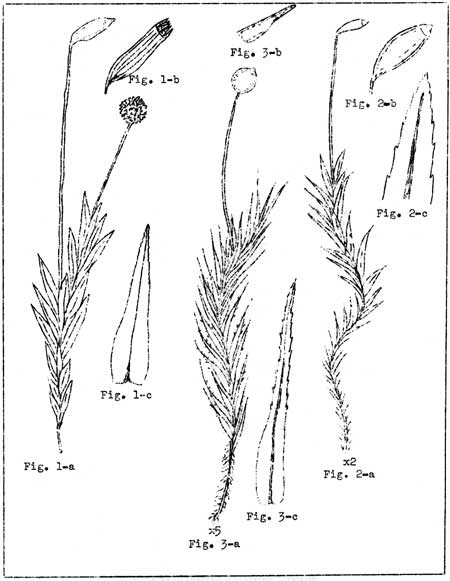
-oOo-

AULACOMNIUM FAMILY -
(AULACOMNIACEAE)
A small group of bright green mosses forming mats that are brownish
below. They are most commonly found growing at the bases of trees at
lower elevations such as around Longmire.
Aulacomnium androgynum L. Schwaegr. is a common moss of the
western coast. It will be recognized without difficulty by the stem tips
bearing a round head of brood bodies which reproduce the plant
vegetatively (See Plate XIII, Fig. 1).
TIMMIA FAMILY (TIMMIACEAE)
Mosses of this family may be confused with the Polytrichaceae when
not in the fruiting condition, but the costa are narrower than those of
Polytrichum, and lamellae are missing. The capsules, when fresh, look
much like those of Mnium or Bryum.
Timmia Austrieca Hedw. collected at Ohanapecosh, is the sole
representative of this family found thus far in the park. The plant is
reddish-orange in color and specimens varied from 5 to 8 cm. in height.
(See Plate XIII, Fig. 2).
BARTRAMIA FAMILY (BARTRAMIACEAE)
Representatives of this family are usually medium or large in size
and, because they prefer moist, shaded habitats, are usually found here
on the sides of the steep-sided glacial canyons where they form mats in
places kept moist by seepage and running water.
Bartramia ithyphylla Brid. is an alpine species frequenting
rock crevices the mountains where it is shaded from the intense rays of
the summer sun.
Two genera, Philonotis and bartramia, are distinguished on the basis
of the longer, lanceolate or linear lanceolate leaves of the latter,
while Philonotis has ovate-lanceolate leaves.
Philonotis capillaris Lindb. is a small form, 1-3 cm. high,
growing in slender, yellowish-green to bright green tufts. This was
collected on the Van Trump Trail at around 5000 feet elevation.
P. Americana Dism. is, as a rule, a robust plant, but the one
specimen collected was a slender form found above Lake Louise.
Bartramia pomiformis Hedw. is very abundant, having been found
at Ohanapecosh, lower Eagle Peak Trail, Van Trump Trail, West Side Road
and along Nisqually River near Longmire. It forms dense or loose tufts
which are very soft to the touch and green or yellowish-green in color.
The globose or ovoid capsule on a fairly long seta makes recognition
easy. (See Plate XIII, Fig. 3.).
B. ithyphylla Brid., the higher form already mentioned, is
short, usually not over 2 cm. high. The roundish capsule is deeply
furrowed when dry. It was collected above St. Andrews Park, in Klapatche
Park, on the Skyline Trail, and above Yakima Park.

PLATE XIII.
Fig. 1. (Aulacomniaceae). Aulacomnium androgynum L. Schwaegr.
1a - entire plant with side shoot showing the brood bodies which
are characteristic of the species. 1b - capsule. 1c - leaf.
Fig. 2. (Timmiaceae). Timmia austriaca Hedw. 2a - entire plant x2.
2b - capsule, magnified. 2c - tip of leaf, magnified.
Fig. 3. (Bartramiaceae). Bartramia pomiformis L. Hedw. 3a - entire
plant x5. 3b - calyptra magnified. 3c - leaf, magnified to show
serrulations.
Descriptions continued...

